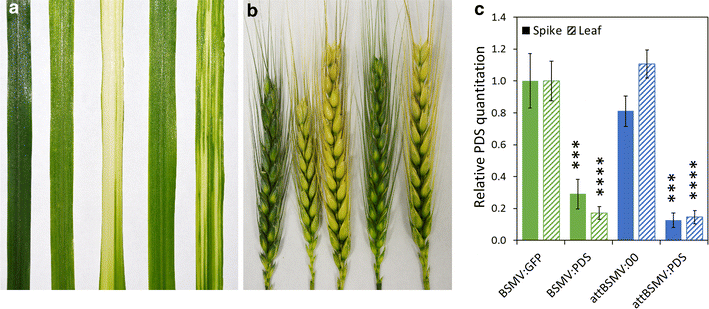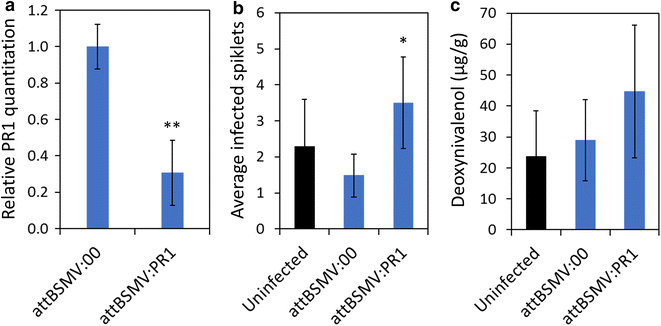Identification of an attenuated barley stripe mosaic virus for the virus-induced gene silencing of pathogenesis-related wheat genes
- PMID: 26839581
- PMCID: PMC4736275
- DOI: 10.1186/s13007-016-0112-z
Identification of an attenuated barley stripe mosaic virus for the virus-induced gene silencing of pathogenesis-related wheat genes
Abstract
Background: Virus-induced gene silencing (VIGS) has become an emerging technology for the rapid, efficient functional genomic screening of monocot and dicot species. The barley stripe mosaic virus (BSMV) has been described as an effective VIGS vehicle for the evaluation of genes involved in wheat and barley phytopathogenesis; however, these studies have been obscured by BSMV-induced phenotypes and defense responses. The utility of BSMV VIGS may be improved using a BSMV genetic background which is more tolerable to the host plant especially upon secondary infection of highly aggressive, necrotrophic pathogens such as Fusarium graminearum.
Results: BSMV-induced VIGS in Triticum aestivum (bread wheat) cv. 'Fielder' was assessed for the study of wheat genes putatively related to Fusarium Head Blight (FHB), the necrotrophism of wheat and other cereals by F. graminearum. Due to the lack of 'Fielder' spike viability and increased accumulation of Fusarium-derived deoxynivalenol contamination upon co-infection of BSMV and FHB, an attenuated BSMV construct was generated by the addition of a glycine-rich, C-terminal peptide to the BSMV γ b protein. This attenuated BSMV effectively silenced target wheat genes while limiting disease severity, deoxynivalenol contamination, and yield loss upon Fusarium co-infection compared to the original BSMV construct. The attenuated BSMV-infected tissue exhibited reduced abscisic, jasmonic, and salicylic acid defense phytohormone accumulation upon secondary Fusarium infection. Finally, the attenuated BSMV was used to investigate the role of the salicylic acid-responsive pathogenesis-related 1 in response to FHB.
Conclusions: The use of an attenuated BSMV may be advantageous in characterizing wheat genes involved in phytopathogenesis, including Fusarium necrotrophism, where minimal viral background effects on defense are required. Additionally, the attenuated BSMV elicits reduced defense hormone accumulation, suggesting that this genotype may have applications for the investigation of phytohormone-related signaling, developmental responses, and pathogen defense.
Keywords: Abscisic acid; Deoxynivalenol; Jasmonic acid; Necrotrophic fungi; Pathogenesis-related 1; Salicylic acid; Vomitoxin; Yield.
Figures





Similar articles
-
Wheat transcriptome profiling reveals abscisic and gibberellic acid treatments regulate early-stage phytohormone defense signaling, cell wall fortification, and metabolic switches following Fusarium graminearum-challenge.BMC Genomics. 2021 Nov 6;22(1):798. doi: 10.1186/s12864-021-08069-0. BMC Genomics. 2021. PMID: 34742254 Free PMC article.
-
A Pathogen-Responsive Leucine Rich Receptor Like Kinase Contributes to Fusarium Resistance in Cereals.Front Plant Sci. 2018 Jun 26;9:867. doi: 10.3389/fpls.2018.00867. eCollection 2018. Front Plant Sci. 2018. PMID: 29997638 Free PMC article.
-
Barley Stripe Mosaic Virus (BSMV)-Based Virus-Induced Gene Silencing to Functionally Characterize Genes in Wheat and Barley.Methods Mol Biol. 2022;2408:85-93. doi: 10.1007/978-1-0716-1875-2_5. Methods Mol Biol. 2022. PMID: 35325417
-
Fusarium Head Blight in Durum Wheat: Recent Status, Breeding Directions, and Future Research Prospects.Phytopathology. 2019 Oct;109(10):1664-1675. doi: 10.1094/PHYTO-03-19-0095-RVW. Epub 2019 Sep 3. Phytopathology. 2019. PMID: 31369363 Review.
-
Transcriptomics of cereal-Fusarium graminearum interactions: what we have learned so far.Mol Plant Pathol. 2018 Mar;19(3):764-778. doi: 10.1111/mpp.12561. Epub 2017 Jun 7. Mol Plant Pathol. 2018. PMID: 28411402 Free PMC article. Review.
Cited by
-
Characterization of Triticum aestivum Abscisic Acid Receptors and a Possible Role for These in Mediating Fusairum Head Blight Susceptibility in Wheat.PLoS One. 2016 Oct 18;11(10):e0164996. doi: 10.1371/journal.pone.0164996. eCollection 2016. PLoS One. 2016. PMID: 27755583 Free PMC article.
-
Gene silencing approaches through virus-based vectors: speeding up functional genomics in monocots.Plant Mol Biol. 2019 May;100(1-2):3-18. doi: 10.1007/s11103-019-00854-6. Epub 2019 Mar 8. Plant Mol Biol. 2019. PMID: 30850930 Review.
-
Virus-Induced Gene Silencing (VIGS) in Aegilops tauschii and Its Use in Functional Analysis of AetDREB2.Mol Biotechnol. 2018 Jan;60(1):41-48. doi: 10.1007/s12033-017-0042-7. Mol Biotechnol. 2018. PMID: 29196985
-
Inoculation of Maize with Sugarcane Mosaic Virus Constructs and Application for RNA Interference in Fall Armyworms.Bio Protoc. 2023 Jul 20;13(14):e4760. doi: 10.21769/BioProtoc.4760. eCollection 2023 Jul 20. Bio Protoc. 2023. PMID: 37497451 Free PMC article.
References
LinkOut - more resources
Full Text Sources
Other Literature Sources

